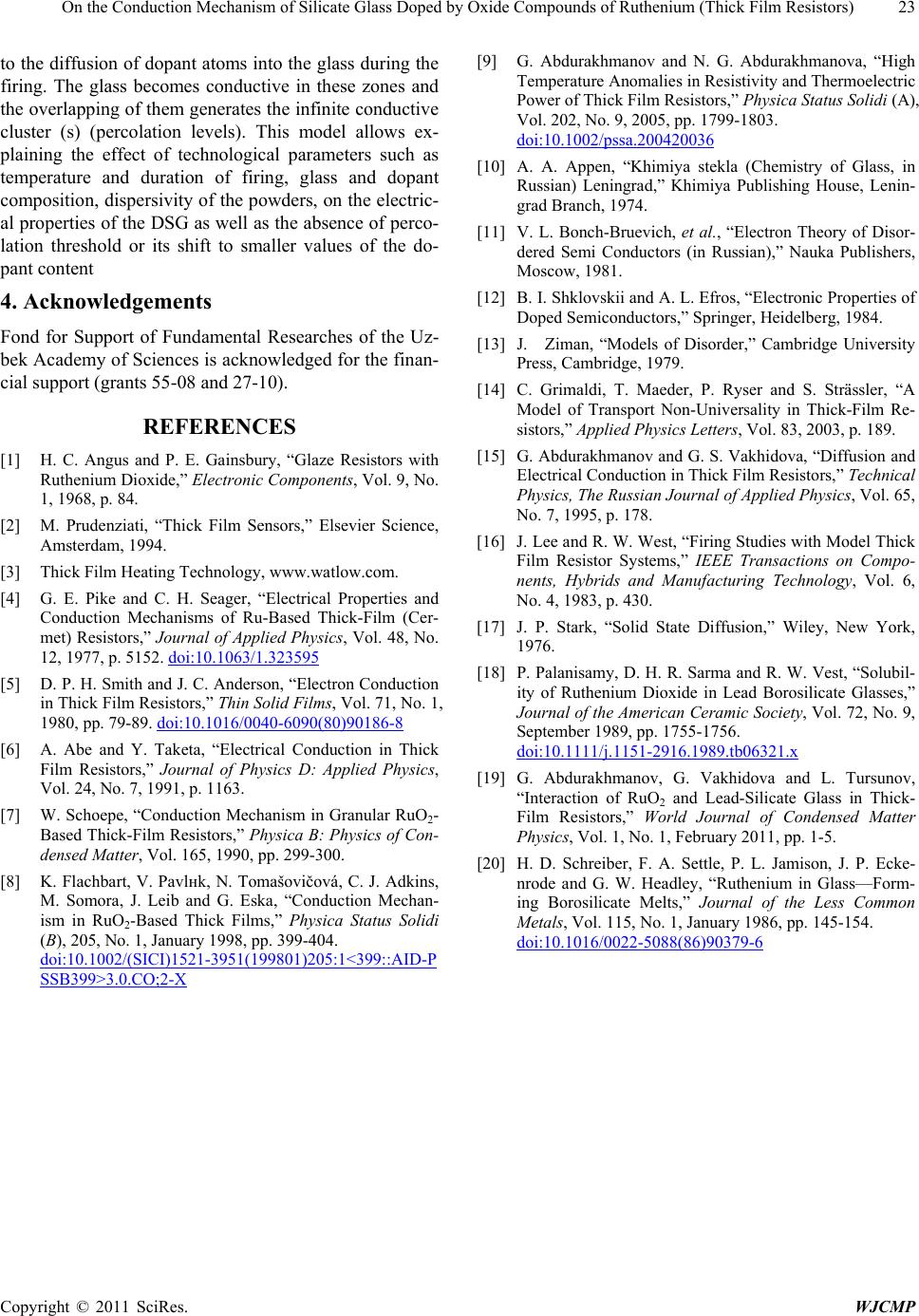
On the Conduction Mechanism of Silicate Glass Doped by Oxide Compounds of Ruthenium (Thick Film Resistors)
Copyright © 2011 SciRes. WJCMP
to the diffusion of dopant atoms into the glass during the
firing. The glass becomes conductive in these zones and
the overlapping of them generates the infinite conductive
cluster (s) (percolation levels). This model allows ex-
plaining the effect of technological parameters such as
temperature and duration of firing, glass and dopant
composition, dispersivity of the powders, on the electric-
al properties of the DSG as well as the absence of perco-
lation threshold or its shift to smaller values of the do-
pant content
4. Acknowledgements
Fond for Support of Fundamental Researches of the Uz-
bek Academy of Sciences is acknowledged for the finan-
cial support (grants 55-08 and 27-10).
REFERENCES
[1] H. C. Angus and P. E. Gainsbury, “Glaze Resistors with
Ruthenium Dioxide,” Electronic Components, Vol . 9, No.
1, 1968, p. 84.
[2] M. Prudenziati, “Thick Film Sensors,” Elsevier Science,
Amsterdam, 1994.
[3] Thick Film Heating Technology, www.watlow.com.
[4] G. E. Pike and C. H. Seager, “Electrical Properties and
Conduction Mechanisms of Ru-Based Thick-Film (Cer-
met) Resistors,” Journal of Applied Physics, Vol. 48, No.
12, 1977, p. 5152. doi:10.1063/1.323595
[5] D. P. H. Smith and J. C. Anderson, “Electron Conduction
in Thick Film Resistors,” Thin Solid Films, Vol. 71, No. 1,
1980, pp. 79-89. doi:10.1016/0040-6090(80)90186-8
[6] A. Abe and Y. Taketa, “Electrical Conduction in Thick
Film Resistors,” Journal of Physics D: Applied Physics,
Vol. 24, No. 7, 1991, p. 1163.
[7] W. Schoepe, “Conduction Mechanism in Granular RuO2-
Based Thick-Film Resistors,” Physica B: Physics of Con-
densed Matter, Vol. 165, 1990, pp. 299-300.
[8] K. Flachbart, V. Pavlнk, N. Tomašovičová, C. J. Adkins,
M. Somora, J. Leib and G. Eska, “Conduction Mechan-
ism in RuO2-Based Thick Films,” Physica Status Solidi
(B), 205, No. 1, January 1998, pp. 399-404.
doi:10.1002/(SICI)1521-3951(199801)205:1<399::AID-P
SSB399>3.0.CO;2-X
[9] G. Abdurakhmanov and N. G. Abdurakhmanova, “High
Temperature Anomalies in Resistivity and Thermoelectric
Power of Thick Film Resistors,” Physica Status Solidi (A),
Vol. 202, No. 9, 2005, pp. 1799-1803.
doi:10.1002/pssa.200420036
[10] A. A. Appen, “Khimiya stekla (Chemistry of Glass, in
Russian) Leningrad,” Khimiya Publishing House, Lenin-
grad Branch, 1974.
[11] V. L. Bonch-Bruevich, et al., “Electron Theory of Disor-
dered Semi Conductors (in Russian),” Nauka Publishers,
Мoscow, 1981.
[12] B. I. Shklovskii and A. L. Efros, “Electronic Properties of
Doped Semiconductors,” Springer, Heidelberg, 1984.
[13] J. Ziman, “Models of Disorder,” Cambridge University
Press, Cambridge, 1979.
[14] C. Grimaldi, T. Maeder, P. Ryser and S. Strässler, “A
Model of Transport Non-Universality in Thick-Film Re-
sistors,” Applied Physics Letters, Vol. 83, 2003, p. 189.
[15] G. Abdurakhmanov and G. S. Vakhidova, “Diffusion and
Electrical Conduction in Thick Film Resistors,” Technical
Physics, The Russian Journal of Applied Physics, Vol. 65,
No. 7, 1995, p. 178.
[16] J. Lee and R. W. West, “Firing Studies with Model Thick
Film Resistor Systems,” IEEE Transactions on Compo-
nents, Hybrids and Manufacturing Technology, Vol. 6,
No. 4, 1983, p. 430.
[17] J. P. Stark, “Solid State Diffusion,” Wiley, New York,
1976.
[18] P. Palanisamy, D. H. R. Sarma and R. W. Ves t , “Solubil-
ity of Ruthenium Dioxide in Lead Borosilicate Glasses,”
Journal of the American Ceramic Society, Vol. 72, No. 9,
September 1989, pp. 1755-1756.
doi:10.1111/j.1151-2916.1989.tb06321.x
[19] G. Abdurakhmanov, G. Vakhidova and L. Tursunov,
“Interaction of RuO2 and Lead-Silicate Glass in Thick-
Film Resistors,” World Journal of Condensed Matter
Physics, Vol. 1, No. 1, February 2011, pp. 1-5.
[20] H. D. Schreiber, F. A. Settle, P. L. Jamison, J. P. Ecke-
nrode and G. W. Headley, “Ruthenium in Glass—Form-
ing Borosilicate Melts,” Journal of the Less Common
Metals, Vol. 115, No. 1, January 1986, pp. 145-154.
doi:10.1016/0022-5088(86)90379-6